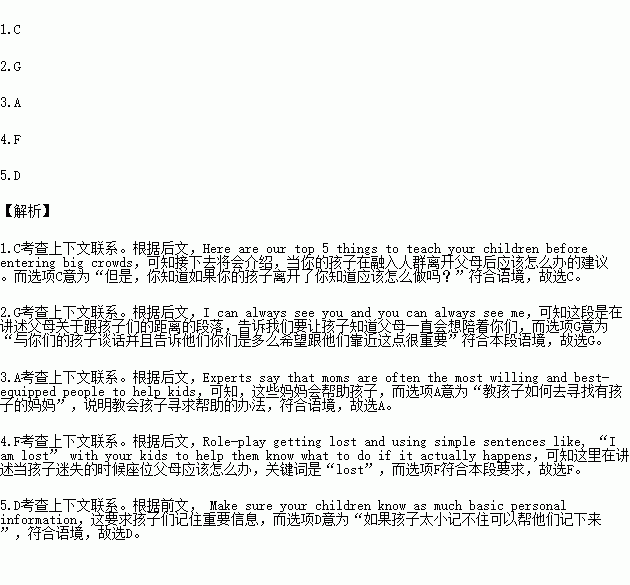题目内容
根据短文内容,从选项中选出能填入空白处的最佳选项。选项中有两项为多余选项。
Summer is the season of family travel. 1. Here are our top 5 things to teach your children before entering big crowds:
How Far They Can Go — 2. For young children, you should set a rule of always holding a parent’s hand. For older kids, you may be comfortable with a “I can always see you and you can always see me” rule.
To Call Your Real Name — Teach your children that you will find them, so it’s best if they stay in one place. What’s more, teach them to call out your full name instead of “Mommy” or “Daddy” to help you more easily find them.
How to Identify a “Safe Person” — Make sure your children know the best people to approach if they get separated from you. Employees working at the place you‘re visiting are generally always good, “safe people”. But what about places that may not have employees, like the beach? 3. Experts say that moms are often the most willing and best-equipped people to help kids.
What to say — 4. Remember that if your children do get separated from you, they will likely be panicked (恐慌), so don’t assume that they will know how to tell strangers that they are lost. Role-play getting lost and using simple sentences like, “I am lost” with your kids to help them know what to do if it actually happens.
Their Personal Information — Make sure your children know as much basic personal information as possible, including their full names, parents’ full names and telephone numbers and the address. 5.
A. Teach your children to look for a mom with kids.
B. Sometimes it’s not hard to find a safe person in such places.
C. But do your kids know what to do if they get separated from you?
D. If your kids are too young to remember them, write them down!
E. It can be hard for people to help a lost child.
F. Tell your children to behave normally when they get lost.
G. It’s important to talk with your children about how close you expect them to stay to you.
 名校课堂系列答案
名校课堂系列答案
